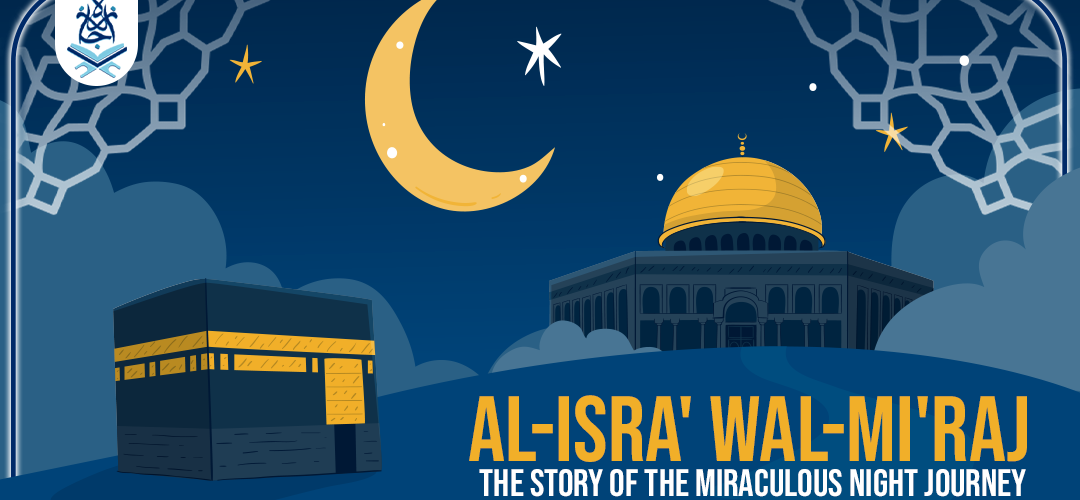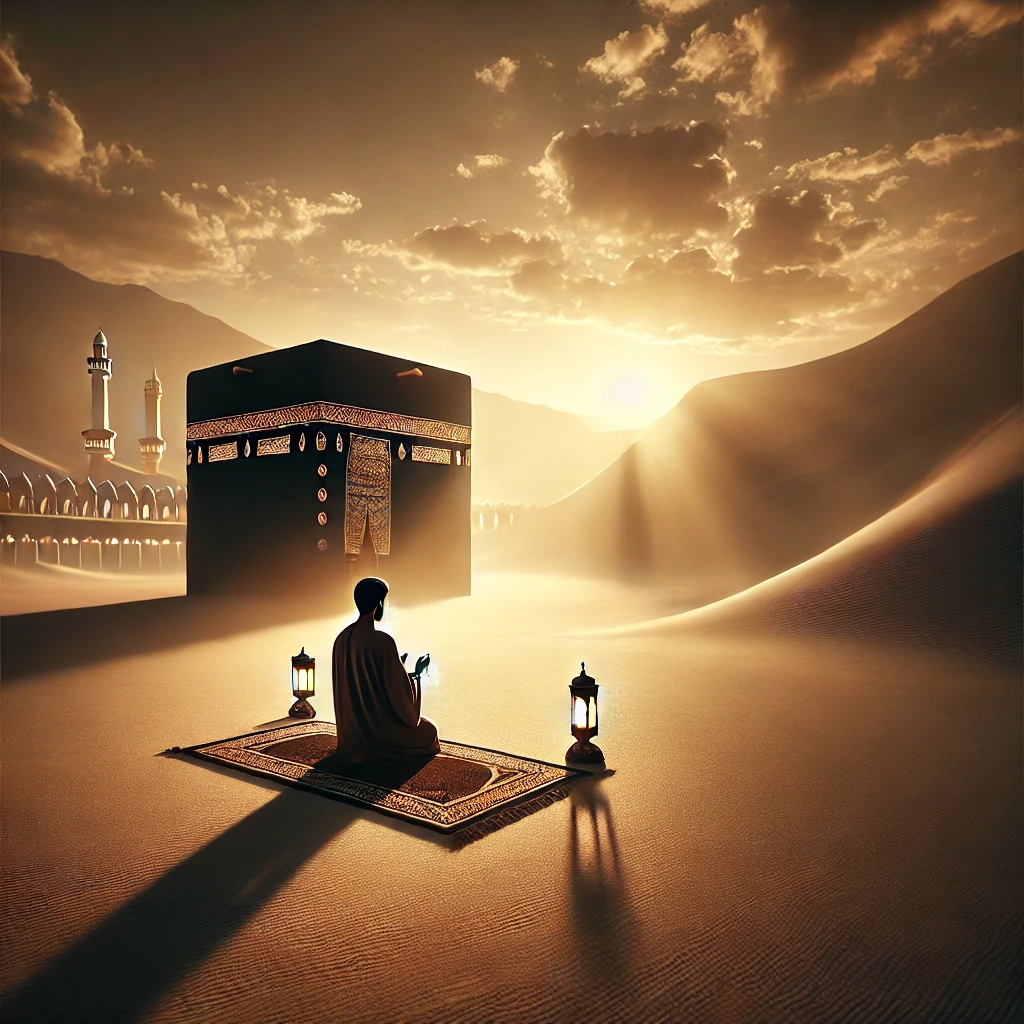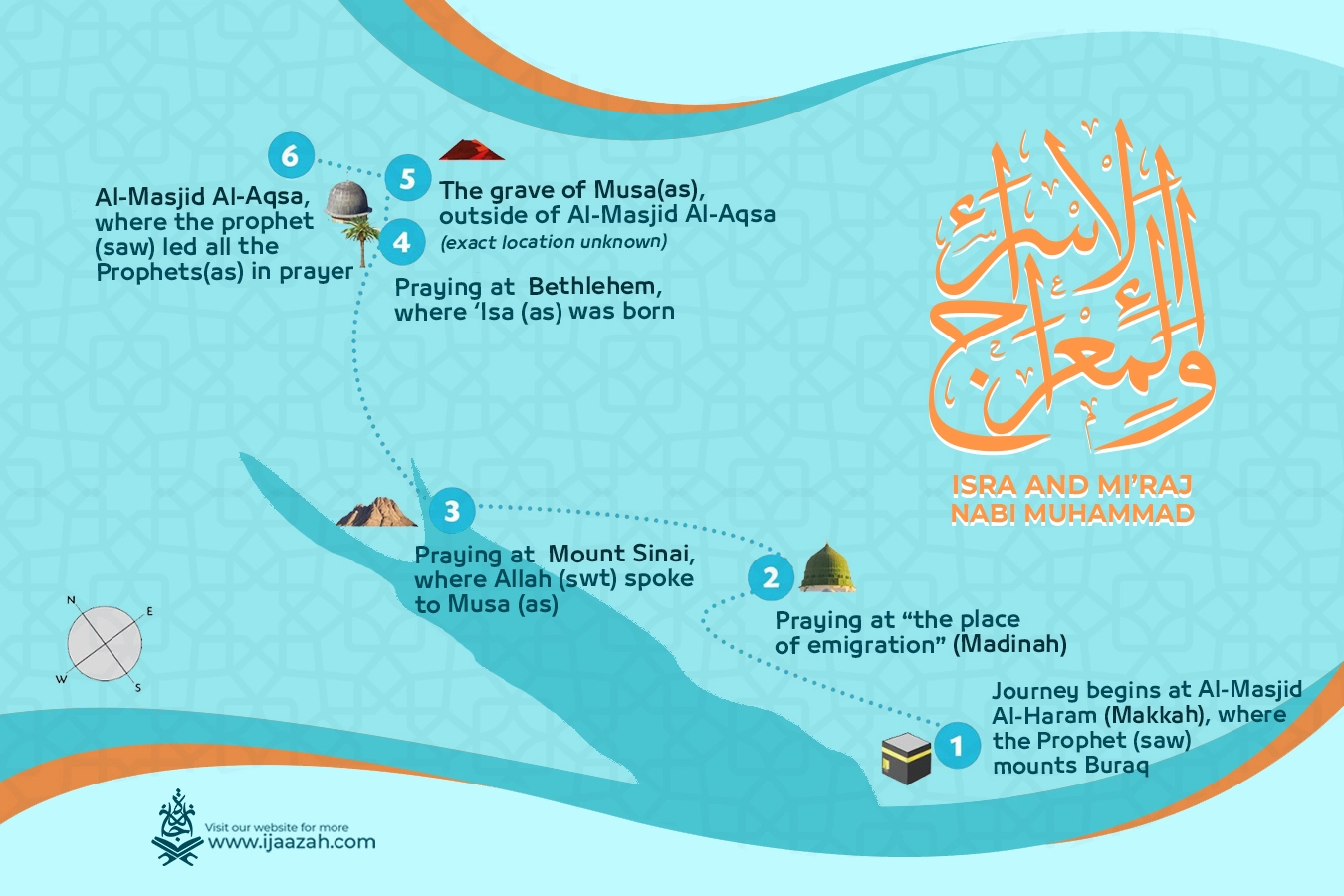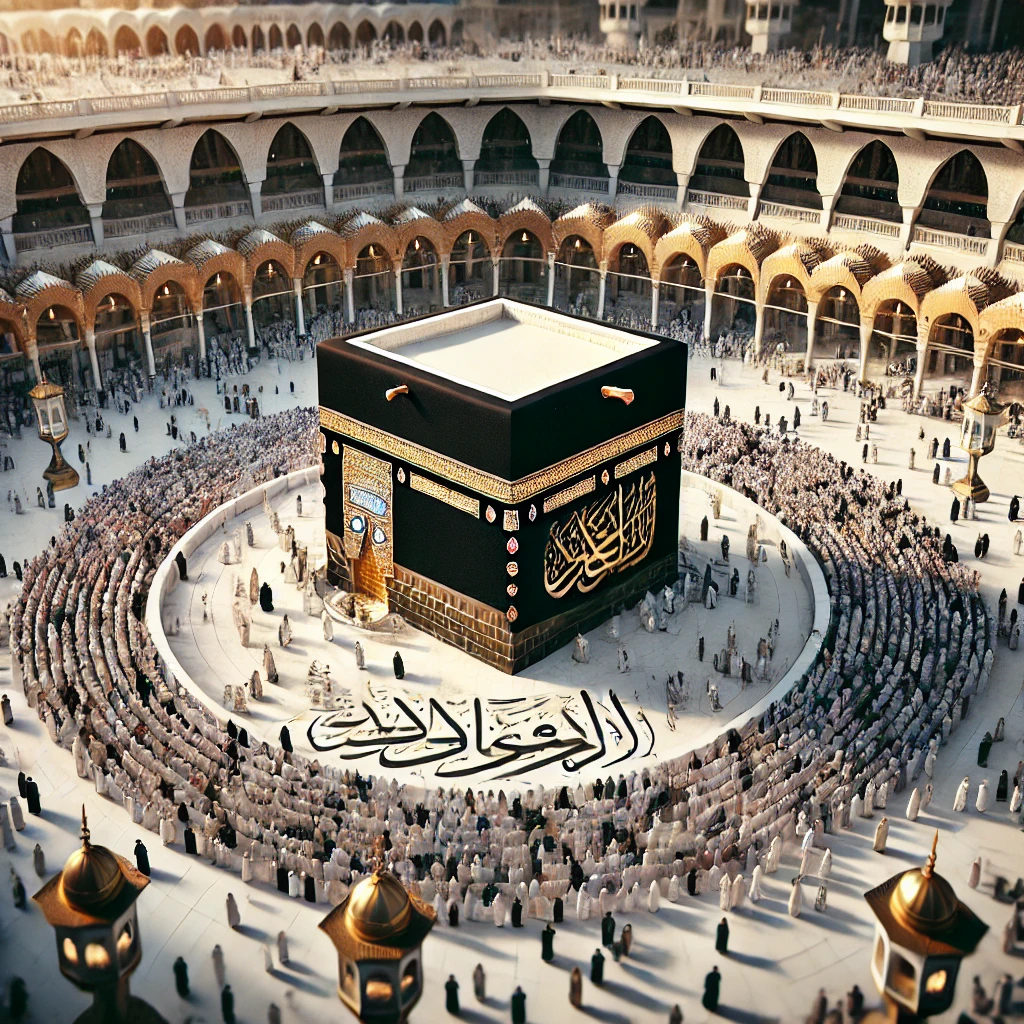Blog
Al-Isra’ wal-Mi’raj: The Story of the Miraculous Night Journey
- February 9, 2023
- Posted by: Tasneem Ragab
- Category: Blog Blessed Days

In the heart of Islam’s earliest days, during a time of trials and challenges for the Prophet Muhammad ﷺ, Allah gifted him with an experience that would forever change his life and uplift the spirits of his followers. This is the story of Al-Isra’ wal-Mi’raj, the miraculous Night Journey and Ascension, a pivotal event that resonates deeply in the hearts of Muslims around the world.
What is Al-Isra’ wal-Mi’raj?
Al-Isra’ wal-Mi’raj refers to two remarkable parts of a single journey that the Prophet Muhammad ﷺ experienced in one night. The event is divided into two stages:
- Al-Isra’: This part of the journey involved the Prophet’s ﷺ miraculous night travel from Mecca to Jerusalem.
- Al-Mi’raj: This was the Prophet’s ﷺ ascension from Jerusalem into the heavens, where he encountered many significant events and individuals.
When Did This Journey Happen?
While the exact date of Al-Isra’ wal-Mi’raj remains debated among scholars, many agree that it occurred roughly around the year 621 CE, about a year before the Prophet’s ﷺ migration to Medina. It was a time of hardship, especially after the loss of two of the Prophet’s ﷺ strongest supporters, his beloved wife Khadijah (RA) and his uncle Abu Talib. This journey brought solace, guidance, and a profound message to the Prophet ﷺ and his followers.
Al-Isra’: The Night Journey from Mecca to Jerusalem

The journey begins in Mecca, in the sacred Masjid al-Haram, where the Prophet ﷺ was resting. It is narrated that Angel Jibril (Gabriel) appeared to him, bringing an extraordinary creature called Buraq. This creature, often described as being white, between the size of a mule and a donkey, and faster than the speed of light, was chosen to carry the Prophet ﷺ on this journey.
With Jibril’s guidance, the Prophet ﷺ set out on the journey from Mecca to Jerusalem, a distance of around 1,500 kilometers. Normally, such a journey would take weeks, but this miraculous travel happened in mere moments.
Upon reaching Jerusalem, the Prophet ﷺ arrived at Al-Aqsa Mosque, a site rich in spiritual history. Here, in a gathering of past prophets, including Ibrahim (Abraham), Musa (Moses), and Isa (Jesus) ﷺ, the Prophet Muhammad ﷺ led them in prayer. This gathering symbolized the unity of the monotheistic message, a bond between the Abrahamic faiths, and the significance of Jerusalem as a holy city in Islam.
Al-Mi’raj: The Ascension to the Heavens
After the prayer in Al-Aqsa, the Prophet ﷺ began his ascent through the heavens, guided by Jibril. This part of the journey, known as Al-Mi’raj, took him to seven levels of heaven, each filled with awe-inspiring encounters.
- First Heaven: Here, the Prophet ﷺ met Adam, the first human being and prophet.
- Second Heaven: He encountered Yahya (John the Baptist) and Isa (Jesus) ﷺ, who welcomed him warmly.
- Third Heaven: Here, the Prophet ﷺ met Yusuf (Joseph) ﷺ, known for his beauty and resilience.
- Fourth Heaven: Idris ﷺ, a prophet mentioned in the Qur’an, greeted the Prophet ﷺ in this level.
- Fifth Heaven: Harun (Aaron) ﷺ, the brother of Musa, welcomed him.
- Sixth Heaven: Musa (Moses) ﷺ awaited him here, showing the deep bond between the Prophet ﷺ and the legacy of Musa ﷺ.
- Seventh Heaven: Finally, the Prophet ﷺ met Ibrahim (Abraham) ﷺ, his ancestor and the patriarch of monotheism, leaning against Al-Bayt al-Ma’mur, the heavenly counterpart of the Kaaba, which is constantly circled by angels.
The Divine Gift of Salah (Prayer)
One of the most profound moments of this journey was the gift of Salah (prayer). The Prophet ﷺ was brought to the Lote Tree of the Farthest Limit (Sidrat al-Muntaha), beyond which even Jibril could not accompany him. Here, Allah ordained the five daily prayers, an act of worship that would become the foundation of Islamic devotion.
Initially, fifty prayers were prescribed, but after counsel with Musa ﷺ, the Prophet ﷺ returned multiple times, each time reducing the number until it reached five. Musa ﷺ suggested further reduction, but the Prophet ﷺ, out of humility and gratitude, accepted five daily prayers as a mercy for his followers, with the promise that these five would carry the reward of fifty.
Lessons and Significance of Al-Isra’ wal-Mi’raj
The Night Journey serves as a source of inspiration, hope, and spiritual guidance for Muslims. Here are a few significant lessons:
- Connection Between the Earthly and the Divine: This journey shows a profound connection between the earthly realm (through Al-Isra’) and the divine realm (through Al-Mi’raj). It reminds Muslims of the closeness they have with their Creator and the importance of spiritual elevation through prayer and devotion.
- Strength in Times of Hardship: Al-Isra’ wal-Mi’raj came to the Prophet ﷺ during one of his most challenging times. It served as a reminder that, despite earthly trials, divine mercy and support are ever-present.
- Unity of Prophethood: By leading the previous prophets in prayer, the Prophet Muhammad ﷺ reaffirmed Islam’s connection with past prophets, highlighting the unity and continuity of Allah’s message throughout history.
- The Centrality of Salah: The gift of Salah, brought directly from Allah, underscores its importance. It is a personal connection with Allah, established through this miraculous journey and emphasized as a constant reminder of faith.
How Al-Isra’ wal-Mi’raj Is Remembered Today
Each year, many Muslims around the world commemorate the Night Journey and Ascension on the 27th of Rajab, the seventh month of the Islamic lunar calendar. Though not universally practiced with specific rituals, the night is often marked with prayers, recitations, and reflections on the significance of Al-Isra’ wal-Mi’raj.
Conclusion
The story of Al-Isra’ wal-Mi’raj is a profound reminder of hope, faith, and spiritual devotion. It illustrates a journey not just of physical movement but of inner growth and closeness to Allah. For Muslims, this event is a testament to Allah’s boundless mercy and the enduring power of faith, even during the hardest times. As we remember this journey, we are reminded of the beauty of Salah, the unity of all prophets, and the divine support that is never far away.
Al-Isra’: From Makkah to Jerusalem

The night travel and climb account starts with Prophet Muhammad s.a.w. voyaging with the blessed messenger Jibril a.s. on a brilliant creation called Buraq to “the most distant mosque” Masjid al-Aqsa, in Jerusalem. The Burqa is one of the creatures of heaven and is portrayed as “a white animal that’s bigger than a jackass but littler than a donkey, who would put its foot (step) a remove rise to the run of his vision.” (Sahih Al-Bukhari)
In other words, the speed that it can travel rises above the known restrictions, indeed nowadays. In a hadith described by Imam An-Nasa’i conjointly said within the tafsir of Ibn Kathir, Jibril a.s. inquired the Prophet s.a.w. to get off and supplicate at several points along the travel of al-Isra’. The primary halt was at Taybah – which was to be the put that the Prophet would before long relocate to and title the city of Madinah. Following, was at Mount Sinai, where Prophet Musa a.s has gotten the disclosure of the Torah from Allah s.w.t. And at long last at Bethlehem, the put where Prophet Isa a.s. was born.
Upon coming to Masjid al-Aqsa, Prophet Muhammad s.a.w. driven all of the prior Prophets a.s. in supplication. Masjid al-Aqsa holds gigantic centrality in Islam because it was the primary qiblah for Muslims and the third holiest location in Islam. It was an image and the domestic of various Prophets sometime recently Prophet Muhammad s.a.w.
Al-Mi’raj: From Jerusalem through the Seven Heavens
The moment portion of the travel brings Prophet Muhammad’s rising to the sky with Jibril a.s. Amid the rising, he met and traded welcome of peace with numerous other Prophets, sometime recently him in different magnificent circles. He met Prophet Adam a.s, taken after by Prophets Yahya a.s and Prophet Isa a.s, and after that with Prophet Yusuf a.s, Prophet Idris a.s, Prophet Harun a.s, Prophet Musa a.s, and finally, Prophet Ibrahim a.s.
When he, at last, comes to the most noteworthy level within the sky, he was brought into the Divine Nearness of the All-powerful Allah s.w.t, alone at Sidratul Muntaha (a boundary past which none may pass). It is said to be the boundary that has never been passed by anybody but by Prophet Muhammad s.a.w. Here, Rasulullah s.a.w. was given the Divine Decree for the devotees to set up everyday prayers.
Upon returning from the Sidaratul Muntaha, Prophet Muhammad s.a.w experienced Prophet Musa a.s. Within the convention, it was depicted that Prophet Musa a.s told our cherished Prophet Muhammad s.a.w that the commandment may maybe be as well overwhelming for his individuals to take after. Understanding this, our cherished Prophet Muhammad s.a.w kept returning to Allah, The Foremost Kind for a lesser number of mandatory supplications for his individuals.
Our Prophet s.a.w is full of cherish and care for his devotees, and this feeling was presented to him by Allah s.w.t. Inevitably, the number of obligatory supplications was diminished to five. Upon being given that by Allah s.w.t, Rasulullah s.a.w did not wish to proceed inquiring for more, and from that point, the home of five everyday supplications was set up.
Nowadays, Muslims implore Allah s.w.t. five times every day, from over the globe, from mosques to houses and numerous places where supplications can be watched. After all, for Muslims, the soil is where we prostrate, and at whatever point we prostrate that’s the ‘masjid’ for us.
Returning Home: From the Seven Heavens to Makkah

The travel of al-Mi’raj closes with the Prophet s.a.w plummeting back to Masjid Al-Aqsa in Jerusalem. On his return home to Makkah, he saw different caravans within the edges and heading towards the city, which he would afterward portray to the individuals of Quraysh as confirmation that he had made this journey in less than a night. There were numerous who did not accept the Prophet and derided him for making such a claim. The companions, be that as it may, never questioned this earth-shattering event.
Hence, this story was a source of ponder and trust, because it proceeds to be for us today. On this night, the finest of creation s.a.w was given the respect of voyaging to the sky and was graced to meet the Divine Nearness.
Commemorating Isra’ & Mi’raj
Considering its noteworthiness, we must commemorate this night’s journey by reflecting on the lessons and expanding our reverence and great deeds. Earlier to Isra’ Mi’raj, Prophet Muhammad s.a.w had shown awesome tolerance within the comfort of hardship, and it is of Allah’s intelligence that He offers His blessings and alleviation to go through hardships. After all, Allah s.w.t. says within the Quran,
فَإِنَّ مَعَ العُسرِ يُسرًا. إِنَّ مَعَ العُسرِ يُسرًا
“For indeed, with hardship [will be] ease. Indeed, with hardship [will be] ease”
(Surah Ash-Sharh, 94:5-6).
It was here that Allah s.w.t. gave Prophet Muhammad s.a.w. He coordinates supervision, direction, and assurance. It was too here that He uncovered the blessing of supplications. Supplications are the Mi’raj (climb) of a devotee to their Ruler and a day-by-day source of quality. With it, we rise to the All-powerful each day, communicate and draw closer to Him. It was so extraordinary that no other disclosures were passed on specifically to Rasulullah s.a.w. next to this Divine Proclaim of building up the everyday supplications.
The five day-by-day supplications shape a key column of Islam. Without supplications, our lives are void of the otherworldly association to Allah s.w.t. Our five day-by-day supplications interface us to our Maker and delay us from this common life to commit ourselves to reply to the call of our Ace.
